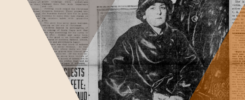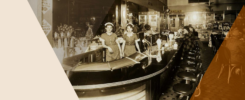Transcript for Episode 2, 2023 Season Talking Hoosier History
George Ade, President Taft, and the Modern Political Campaign
Written and produced by Jill Weiss Simins
When writer and humorist George Ade awoke on a seemingly average August morning in 1908, he thought he’d start with the newspaper and likely a cup of coffee which he found “an aid to composition.” He may have been looking forward to a day of writing, catching up on correspondence, or enjoying the 417-acre grounds of his Hazelden estate near Brook, Newtown County, Indiana – perhaps a stroll through the gardens or a swim in the pool. But when he settled in to read that day’s Indianapolis Star, he received a shock. The front-page headline announced, “Ade’s Farm Rally Will be Big Event.” Charles S. Hernly, Chairman of Indiana’s State Republican Committee, told the Star that state and national party candidates and leaders would rally at Hazelden on September 30 for “the biggest Republican event Indiana will see this campaign.” Hernly colorfully expounded on the day’s details for reporters. He listed the names of the prominent politicians who would speak, “all the big guns.” And he promised a feast for the Midwestern farmers invited to attend: coffee, bread and butter, potatoes, and roast beef from forty of Ade’s best beef cattle. Most notably, the 1908 presidential campaign of William Howard Taft would be launched at this event at Ade’s estate — a brilliant political strategy that would forever change how politicians of both parties campaign to this day.
And George Ade didn’t know anything about it.
I’m Justin Clark and this is a short episode of Talking Hoosier History.
[Archival sound bite of 1912 Taft speech, “Who Are the People?” accessed American Voices]:
“We should lead the way and all doubt as to our constitutional authority should be resolved in favor of our stepping forward as a nation.”
William Howard Taft was Theodore Roosevelt’s handpicked successor to the presidency and thus had the backing of a beloved president and the powerful Republican political machine. And Taft easily won the nomination at the June 1908 Republican National Convention in Chicago. But he had an image problem – one that could lose him the essential votes of farmers, laborers, and African Americans. As an U.S. Circuit Court of Appeals judge, he made several anti-labor decisions. In 1894, Taft had ruled against the railroad workers of the Chicago Pullman Strike. Taft’s Democratic opponent William Jennings Bryan, on the other hand, was a populist who appealed to laborers and farmers by promising to protect their interest from the Republicans, who he claimed were backed by exploitative big business.
The Indiana Republican Party was also in trouble as candidates argued over temperance – should Indiana be totally dry or should communities decide for themselves in local elections? Republican leaders thought that a visit from a national candidate would unify the party at least for long enough to push through a Republican state ticket. And so, Hernly hatched the plan that George Ade had read over his morning paper: a flamboyant event with a big– name speaker to generate enthusiasm for the party. Taft was the obvious and top choice for a headliner.
Ade was an enthusiastic Republican, a sort of figurehead for the party, and had served as a delegate to the Republican National Convention where Taft was nominated. If he were to refuse to host this now public event, he risked further demoralizing the already troubled Indiana Republican Party. If Hernly meant to force Ade’s hand, it worked. George Ade agreed that the “biggest Republican rally of the coming campaign” could be held in his backyard.
But Taft was a reluctant candidate. His life’s goal was to serve as Chief Justice of the Supreme Court, not president. (Though he would eventually cross that off his bucket list as well). Nevertheless, Taft answered the party’s call for his leadership and with his advisors crafted a brilliant strategy to take on Bryan, win the 1908 election, and change campaigning forever. He accepted Hernly’s invitation and on September 23, 1908, Taft and his staff boarded a five-car train dubbed “The Taft Special” and headed for Indiana.
Let’s take a little break in our story to talk about why this story is relevant today. Right now, you could turn on your tv, open your email, or check social media and you’d probably find a presidential candidate asking for your vote. Maybe they’ve even come to your hometown, delivered a speech in the high school gym, and ordered the pork tenderloin at the local mom and pop joint – making sure to be caught on camera of course. We’re used to candidates appealing directly to us, but it wasn’t always like this.
In fact, for much of U.S. history, such active campaigning was seen as power hungry, uncouth, and beneath the dignity of the office. During the 1888 presidential campaign, for example, Hoosier candidate Benjamin Harrison and incumbent President Grover Cleveland mostly stayed home. Harrison ran a successful “front porch” campaign, speaking to crowds that gathered at his Indianapolis home and the reporters he invited to cover the event. He let his supporters do the electioneering instead. Party organizers produced posters and political cartoons, delivered speeches, organized rallies and parades, and produced one memorable publicity stunt. A Harrison supporter in Maryland built a steel and canvas ball and rolled it 5,000 miles across the country to Benjamin Harrison’s home. The idea was to draw comparisons between the candidate and his popular grandfather William Henry Harrison with the slogan, “Keep the Ball Rolling.” All the while, Harrison stayed home – and it worked. He won the election. This was the norm and continued for the following twenty years of elections.
So, what changed? Let’s check back in with our story to find out.
The “Taft Special” arrived at Ade Station just west of Brook, Indiana, on September 23, 1908. George Ade and a welcome committee arrived in a six-car caravan to take Taft, staff, and guests to Hazelden. With Taft in Ade’s automobile, the group passed through town under welcoming signs and triumphal arches made of evergreens and marigolds stretching across main street. At Hazelden, the Purdue military band played, and local politicians warmed up the crowd. When the Taft party appeared, so many fireworks filled the sky that a newspaper reported that “the air was filled with smoke as if from battle.” The stage was set.
Ade introduced the much-anticipated candidate who quickly won over the crowd. Taft had remembered Ade, who had served as part of the notification committee when he accepted the party’s nomination. He made several jokes alluding to Ade’s humorous plays, showing that he was a fan. Then, Taft got down to brass tacks.
[Archival sound bite of 1912 Taft speech, “Who Are the People?” accessed American Voices]:
“So, may we not expect in the issues which are now before us that the ballots cast in November shall show a prevailing majority in favor of sound progress, great prosperity upon a protective basis, and under full constitutional and representative rule by the people.”
He looked out at the faces of the farmers, the constituents that brought him to Indiana, and addressed them directly. He wanted this point to hit home, stating:
I was told if I came here I should have the privilege of meeting 10,000 farmers of the State of Harrison and [former Indiana Governor Oliver P.] Morton, and I seized the opportunity to break my journey to Chicago to look into your faces and to ask you the question whether your experience as farmers with Mr. Bryan and your recollection of his course since 1892 is such as to command him to you as the person into whose hands you wish to put the executive power over the destinies of this nation for four years.
In other words, Taft implied: I came here to talk to you directly and honestly, unlike Bryan, who didn’t stop between big cities and doesn’t have your interests in mind. Taft continued to attack Bryan’s record in the House as a supporter of tariff bills that hurt the working man. In contrast, he espoused the progressive policies of the Republican administration that had directly improved farmers’ lives. He especially focused on the administration’s introduction of free rural mail delivery, which connected farmers to new ideas, spread the latest news, and reduced the feeling of isolation which affected many rural people. Taft’s direct appeal to the farmers worked. The Brook Reporter could scarcely believe that “Mr. Taft would notice a small town like Brook.” That November, Hoosier farmers went to the polls. And while the split in the Indiana Republican Party proved fatal to the state ticket, Hoosiers chose Taft by over 10,000 votes. Taft was inaugurated March 4, 1909, as the twenty-seventh President of the United States.
But William Jennings Bryan had also been travelling across the country like an evangelist, delivering long speeches and criticizing Taft’s anti-labor record. Perhaps then, Bryan should also get the credit for launching the whistle stop campaigning that became standard practice. However, it wasn’t until Taft began actively campaigning to rehabilitate his image and make himself likable to voters, as opposed to simply spreading an educational message – that we get the kind of spectacle politics we recognize today.
Taft’s campaign was strikingly modern in other ways too. Speeches by presidential candidates were traditionally quite long – an hour of expounding on the party platform, like Bryan was doing, was not unusual. But Taft kept it short, speaking for thirty minutes max at major events, and sometimes spending only five minutes joking with crowds on train platforms like he did in Indianapolis. Bryan, known for lengthy rhetoric, also made the switch to shorter speeches, emulating Taft. He recorded a series of two-minute speeches on a wax cylinder for Thomas Edison’s National Phonograph Company. Of course, Taft then had to do the same. Thus, we get the modern sound bite.
[Archival Audio of Taft speaking on Edison reel accessed All Things Considered from NPR]
“It is cowardly to lay down the burden until our purpose is achieved.”
Taft’s Indiana visit marked a sea change in campaign strategy. At Hazelden, Taft introduced the political tactics into his repertoire that helped win him the election. He promoted the Republican platform as a progressive agenda that would benefit farmers and laborers. He crafted a likable, jovial, and personable image by speaking casually and humorously with crowds, while still seriously addressing their concerns. He went on the offensive against his opponent, stopping in many places where Bryan had recently spoken and rebutting his opponent’s statements. And perhaps, most importantly, he shook hands and flashed that unbeatable Taft smile at as many voters as his schedule would allow. Through sheer spectacle and charm, the man who had squashed labor strikes as a judge was now the candidate of the working man. The 1908 election became the first where the Republican and Democratic candidates campaigned actively – an irreversible break with convention, as we now see each election cycle through social media, a steady stream of ads, and even late-night shows. It’s enough to make you nostalgic for the ol’ front porch.
If you want to learn more about this topic read “Republican Game-Changer: 1908 Taft Rally in Indiana” by IHB historian Jill Weiss Simins at the Indiana History Blog. We’ll put the link in the show notes.
Markers are also a great way to learn about Indiana political history. Let’s look at one commemorating the political career of a Democrat to balance things out a little. Samuel M. Ralston was born in Ohio in 1857 and his family moved to Indiana in the 1870s. Ralston eventually settled in Lebanon in Boone County, Indiana, where he opened a law office. A lifelong Democrat and progressive politician, Ralston was elected governor of Indiana in 1912. As governor, he advanced reforms such as the establishment of a Public Service Commission to regulate utilities. He also organized emergency relief during the Great Flood of 1913 and, later that year, he helped resolve the Indianapolis streetcar strike. As part of the state’s centennial, he urged the creation of the Indiana Historical Commission, the predecessor of the Indiana Historical Bureau, as well as the first Indiana state parks. In short, Ralston met the challenges posed by Indiana’s transition to a more urban and industrial state. He was elected to U.S. Senate in 1922 and considered for a presidential candidate in 1924. Of course, it wasn’t all great. As senator, Ralston voted for the Immigration Act of 1924, which established the quota system, effectively banning immigrants of certain ethnicities. To learn more about that issue, read, “’America First:’ The Ku Klux Klan Influence on Immigration Policy in the 1920s” at the Hoosier State Chronicles Blog. We’ll put that link in the notes as well.
We hope you liked this short episode of the podcast. Let us know! Subscribe, rate, and review us wherever you get your podcasts. Once again, I’m Justin Clark, and this has been Talking Hoosier History. Thanks for listening.
SHOW NOTES
Written and produced by Jill Weiss Simins. Performed by Justin Clark. Research and editing support from Dr. Michella Marino.
This episode is based on the article “Republican Game-Changer: 1908 Taft Rally in Indiana” by Jill Weiss Simins. It is available on the Indiana History Blog where you can also find notes and sources, along with images.
Other Links:
Jill Weiss Simins, “’America First:’ The Ku Klux Klan Influence on Immigration Policy in the 1920s,” Hoosier State Chronicles Blog.



